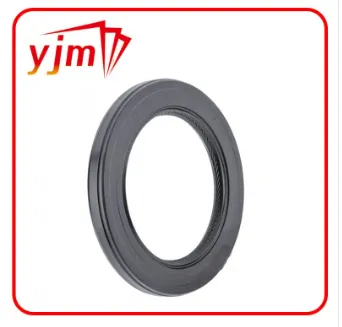Keeping the Engine Tight: The Role of Crankshaft Seals and Gaskets in Oil Control
Your engine’s performance, reliability, and longevity depend heavily on its ability to retain oil and prevent leaks. One of the most critical systems ensuring this is the crankshaft sealing assembly, including the crankshaft front oil seal, crankshaft gasket, and the crankshaft main bearing seal. While small and often overlooked, these components form the first line of defense against oil loss and contamination. In this article, we’ll explore the function, importance, and maintenance of the crankshaft gasket seal, crankshaft main oil seal, and related parts.

What Is the Crankshaft Front Oil Seal?
The crankshaft front oil seal is a circular seal located at the front end of the engine, where the crankshaft protrudes through the timing cover to connect to the harmonic balancer or pulley. Its primary job is to keep engine oil from leaking out of the crankcase while allowing the crankshaft to spin freely.
A properly functioning crankshaft front oil seal is essential because:
It prevents oil leaks around the front pulley
It helps maintain correct oil pressure
It protects belts and accessories from oil contamination
Over time, this seal can wear out due to friction, heat, or age. Common symptoms of a failing front oil seal include oil dripping from the bottom of the timing cover, visible oil spray near the crank pulley, or a burning smell from oil contacting hot engine parts.
Replacing the crankshaft front oil seal often involves removing the serpentine belt, harmonic balancer, and sometimes even the timing cover, depending on the vehicle. Many technicians recommend replacing this seal during a timing belt or chain service to save on labor costs.
Understanding the Role of the Crankshaft Gasket and Crankshaft Gasket Seal
While seals handle rotating surfaces, gaskets are used between stationary components to prevent oil and fluid leaks. The crankshaft gasket typically refers to the gasket used at the rear main bearing cap or the oil pan where the crankshaft passes through.
The crankshaft gasket seal works hand-in-hand with the oil seal to ensure there are no leak paths where the crankshaft sits inside the engine block.
Key functions of the crankshaft gasket include:
Preventing oil seepage between mating surfaces of engine parts
Providing a flexible yet strong barrier against high-pressure oil systems
Ensuring alignment and torque consistency for bearing caps
If the crankshaft gasket fails, you may notice slow oil leaks or seepage around the oil pan or bearing cap area. This often requires resealing the area, which may involve lifting the engine or removing major components.
Modern engines use silicone-based, multi-layer steel, or rubber-impregnated gaskets for superior sealing and longevity. It’s critical to use the correct torque specs and follow the proper installation procedure to avoid uneven sealing or damage to the gasket surface.
When to Replace the Crankshaft Main Bearing Seal or Crankshaft Main Oil Seal
The crankshaft main bearing seal, often referred to as the crankshaft main oil seal, is located at either the front or rear of the crankshaft. These seals are responsible for containing oil where the crankshaft rotates through the engine block. The rear main seal, in particular, is known for being labor-intensive to replace.
Signs you need to replace the crankshaft main oil seal:
Oil leaking from the rear of the engine (especially near the transmission bell housing)
Unexplained oil loss
Slipping clutch (in manual transmission vehicles due to oil contamination)
Low oil pressure warnings with no visible external leaks
Unlike external gaskets, a worn crankshaft main bearing seal can lead to significant oil loss and, if left unchecked, permanent engine damage due to oil starvation. Replacement often requires separating the engine from the transmission, so many drivers combine it with a clutch job or major engine service.
When replacing the crankshaft main oil seal, it’s important to:
Inspect the crankshaft surface for scoring or damage
Replace any wear sleeves if needed
Use quality seals made from Viton or advanced synthetic rubber for long life
Apply a light coat of oil or sealant if recommended by the manufacturer
Final Thoughts
A well-sealed crankshaft is vital to engine health. From the front-facing crankshaft front oil seal to the internal crankshaft gasket seal and the crucial crankshaft main oil seal, each component plays an irreplaceable role in oil management. Addressing leaks early and using the right parts can prevent severe engine damage and keep your vehicle running smoothly.
If you're seeing oil where it shouldn't be—whether near the crank pulley, oil pan, or transmission—don't ignore it. A proactive approach to maintaining your crankshaft gasket and sealing systems can save time, money, and serious engine trouble down the road.
-
The Ultimate Guide to Car Repair Kits: Tools and Essentials Every Driver Should Own
ਖ਼ਬਰਾਂ Aug.01,2025
-
The Complete Guide to Oil Pan Gaskets: Sealing Engine Leaks the Right Way
ਖ਼ਬਰਾਂ Aug.01,2025
-
Preventing Oil Leaks: A Complete Guide to Oil Pan Gaskets and Drain Seals
ਖ਼ਬਰਾਂ Aug.01,2025
-
Everything You Need to Know About Oil Pan Gaskets and Drain Plug Seals
ਖ਼ਬਰਾਂ Aug.01,2025
-
Essential for Car Owners: How to Use a Car Repair Kit to Deal with Minor Breakdown
ਖ਼ਬਰਾਂ Aug.01,2025
-
Comprehensive Guide to Engine Oil Sump Gaskets and Related Seals
ਖ਼ਬਰਾਂ Aug.01,2025
-
The Ultimate Guide to Boat Propeller Bearings and Trailer Wheel Bearings
ਖ਼ਬਰਾਂ Jul.31,2025
ਉਤਪਾਦਾਂ ਦੀਆਂ ਸ਼੍ਰੇਣੀਆਂ















